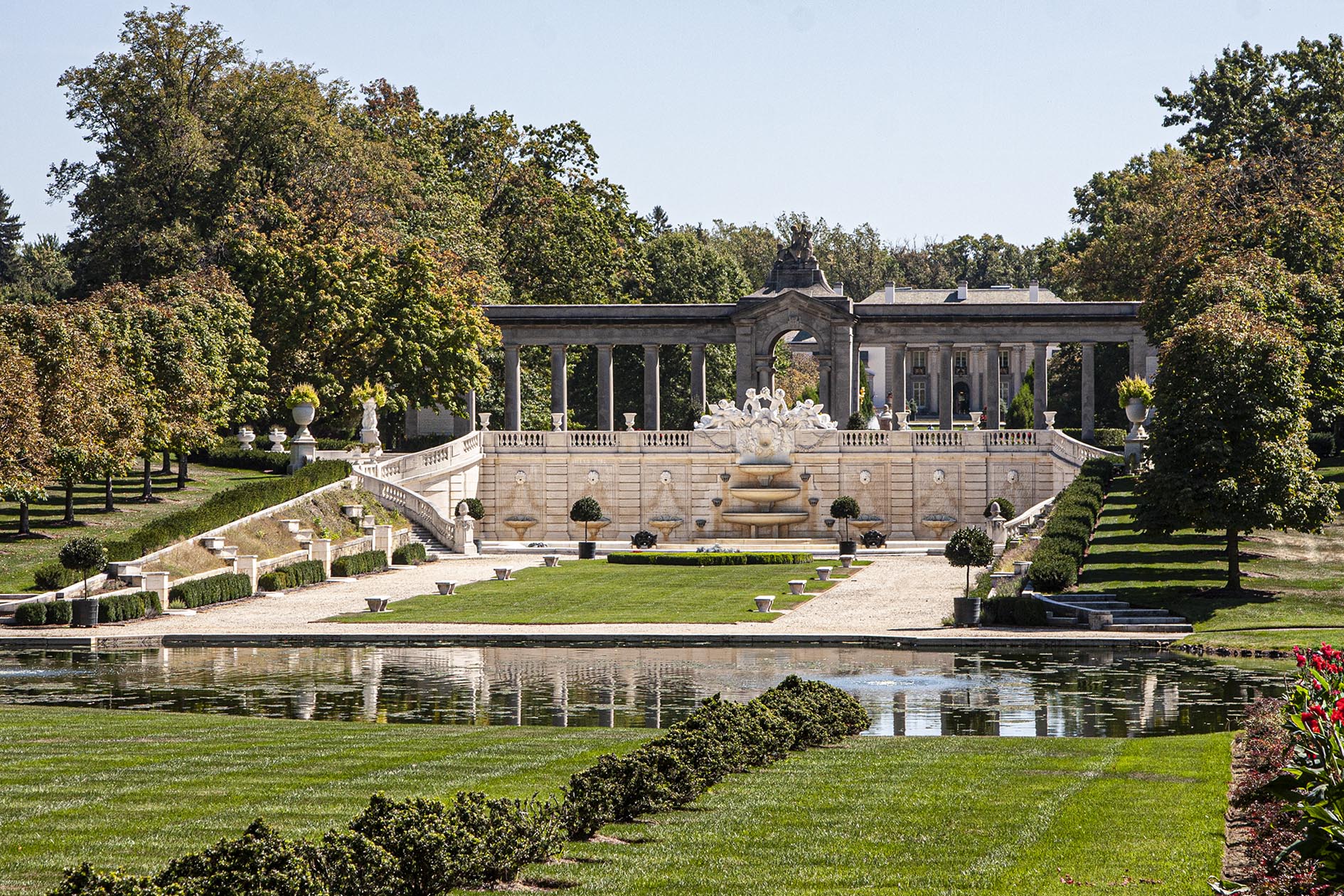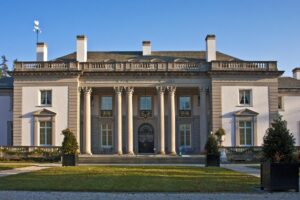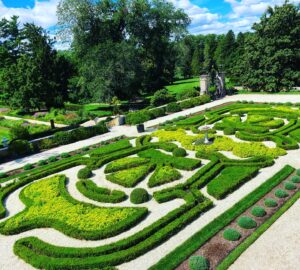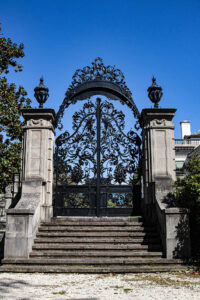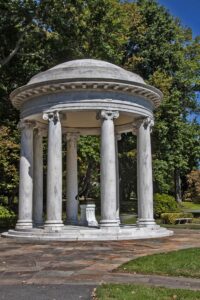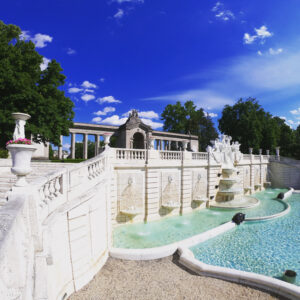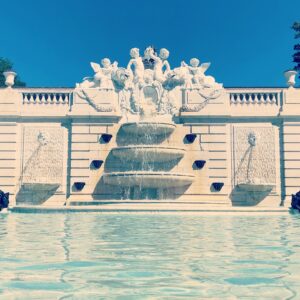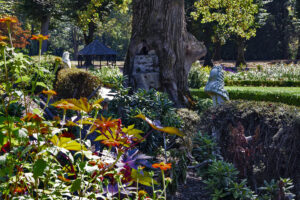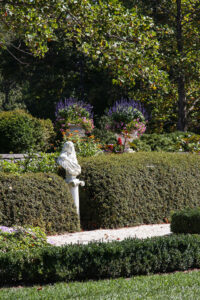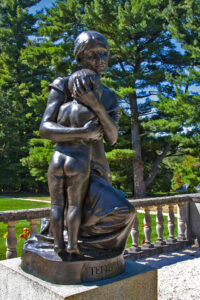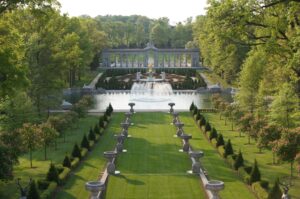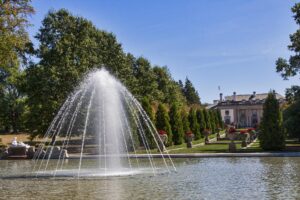If the gardens and mansion at Alfred I. du Pont’s Delaware estate, Nemours, were built to impress, they were also designed to charm. The regimented and often stiff qualities of formal French gardens – and that is how Nemours is classed – here often slip into a more playful character that makes their grandiose pools, colonnade, fountains and sweeping staircases seem almost intimate.
The wow factor never seems formidable, even though the estate’s inspiration was Marie Antoinette’s mansion at Versailles, Le Petit Trianon. The name itself came from Nemours, France, which duPont’s great-great-grandfather, Pierre Samuel du Pont de Nemours, represented in the French Estates General before the French Revolution.
Standing on the front steps of the Nemours mansion and gazing down the Long Walk to the immense Reflecting Pool and white Colonnade, it would be easy to think you’d been transported to the gardens of a European royal place. But these are gardens that invite strolling and exploring, not just standing on the mansion steps and admiring for their expanse and harmonious design.
Before doing that, however, take time to tour the mansion itself, not only to get the history, but for a feel for the era and the players on this sumptuous stage. Despite all the grandeur, the duPonts come across as quite likable.
The expansive reception hall sets the tone of this 77-room mansion, with a dramatic checkerboard floor of black and white marble, a mantel of gilded stone, and an ornately coffered ceiling. From there, visitors can roam the rooms at leisure, with a host in each one to answer questions and share details.
These details are what give Nemours Estate its special charm – the musical instruments hidden in the décor of the Music Room, the small priceless works of art casually hanging in a bedroom, the bowling alley with walls of cypress wood, an entire freezer dedicated to ice cream, the sunny conservatory, the crystal chandelier in the dining room. For opulence, Nemours rivals its contemporary Gilded Age palaces in Newport.
Before leaving to explore the gardens, step through the glass doors of Mrs. duPont’s bedroom onto the second-floor terrace, for a birds-eye view of two of the gardens. Just below are parterre beds of low manicured boxwood outlining perfectly matched beds in curving designs at either side of a fountain. You really must see the pattern from this lofty perch to appreciate the intricate symmetry before you descend to stroll through them.
From here you can also overlook a lower garden, the Four Borders, an 8,500-square-foot expense of lawn delineated by wide beds of annuals and perennials. Shading one side is a huge tulip poplar and at the upper corner steps lead to the ornate 20-foot Russian Gates, forged in the 1700s to honor Catherine the Great.
The gates bring you back to the mansion’s front and the view that’s been called the finest garden vista in America. The Long Walk is an impeccably manicured lawn walk bordered by fountain urns and Japanese cedar, extending downward from the mansion to the Reflecting Pool. The 40-foot-diameter pool surrounds the Art Nouveau-inspired marble statues of the Four Seasons Fountain. When the fountain is active, water jets shoot to 12 feet above the pool surface.
Beyond that is the formal Maze Garden, an intricate design of barberry and arborvitae around a flamboyant gold-leafed statue of Achievement. The vista appears to end with the white pillars of the Colonnade, a classically inspired monument to duPont forbears.
The formal gardens don’t end there, however. When you reach the Colonnade you can see the Sunken Gardens dropping off at the other side, designed in 1930 by duPont’s son, architect Alfred Victor duPont. A waterfall cascades down from a small terrace behind the Colonnade, into a pool, with mosaic-lined grottos reminiscent of the follies at 19th-century French and Italian palaces.
The walls and steps that descend at either side of the waterfall are Italian travertine, and the statuary is Carrara marble. Bronze figures decorate the pool and fountains along the wall. The long sunken garden, edged in boxwood hedges and beds of colorful begonias, ends at a natural pond.
The formal garden continues at the other side of a bridge, where a grass sward edged with canna lilies and bordered by paths leads to the Temple of Love. This classically inspired white temple shelters a bronze statue of Diana the Huntress cast by Jean-Antoine Houdon. From this vantage point the view is in reverse, past the Sunken Gardens and their waterfall, up to the Colonnade and Nemours mansion on the rise behind it.
Nemours is not all about the formal gardens, and two more places should be on your itinerary here. Following a path to the right of the temple (as you face Nemours), you’ll find an intimate rock garden of dwarf evergreens and bulbs alongside a stream. Following a path to the left brings you to the tree-lined allee leading from the Visitor Center to the mansion. Crossing it you’ll find the Oriental Garden, a serene and shaded place with a stone arch bridge and a Chinese gate.
Natural woodlands surround the mansion and gardens, part of Alfred I. du Pont’s 320-acre estate. The industrialist was known as a generous benefactor, and a portion of the estate grounds have become the Alfred I. du Pont Hospital for Children, which he established in 1940.
The surrounding woodlands are home to more than 70 species of birds, as well as white-tailed deer, red foxes, opossums, raccoons, groundhogs, fish, and aquatic animals. Beehives and a 4-H vegetable garden are more recent additions, and a plan is underway to capture rainwater from the estate and hospital to be stored in underground cisterns to use for irrigation and the fountains. The one-acre Reflecting Pool alone takes 800,000 gallons to fill and the fountains need 200,000 more.
Alfred I. duPont and generations of his family before him built their fortunes as inventors and innovators – you’ll see some of his inventions, including an early air-conditioning system, as you tour the house. So we cannot help believing that he would be very pleased to see how his estate is moving with the times.
Side Trip
Garden and art lovers will find a lot to like within a few miles of Nemours Estate Gardens in the Brandywine Valley. The Delaware Art Museum in Wilmington has one of the nation’s foremost collections of works by American illustrators, as well as glass art by Dale Chihuly and a sculpture garden. The Brandywine River Museum of Art exhibits paintings by the Wyeth family of artists and their contemporaries.
Three other duPont estates have become major attractions. Longwood Gardens is one of the foremost show gardens in America, and although it’s better known for its premier collections of American antiques and arts, Winterthur’s gardens are well worth visiting. Hagley Museum, the powder works that produced gunpowder for the War of 1812, is a multi-faceted experience with the original gunpowder works, a historic home, a workers’ village and other things to see.
By Barbara Radcliffe Rogers
Europe Correspondent, Planetware
Luxury Travel Editor, BellaOnline
Features, Global Traveler Magazine
https://worldbite.wordpress.com

